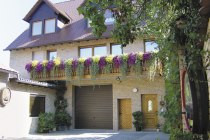Gau-Bischofsheimer Glockenberg
Ring, ring, clang - Let the bells and glasses ring!
In any case, we are talking about church bells. The location was first mentioned in a document in 1401 with the name "an dem glockinberge". Supposedly, the name is based on the fact that the yield of the site was to be given to the bell-ringer of the time. The bell-ringer used to be responsible for pulling the bell ropes. Today this is done mechanically. In the single vineyard, you can actually hear the chimes of the surrounding villages - how fitting. The soil here consists of light loess and is well suited for late-ripening varieties such as Riesling, Silvaner and Pinot Blanc, Gris and Noir. On top of the mountain: the Glockenberghütte with a magnificent panorama over the Rheinhessen landscape with its hills, across the river Rhein to Taunus and Odenwald.
> Discover the single vineyard via the Little Mainz High Trail:
https://www.rheinhessen.de/kleiner-mainzer-hoehenweg-3











